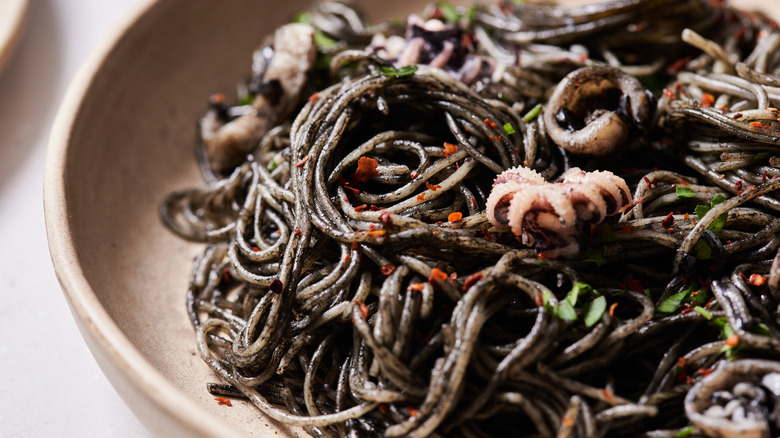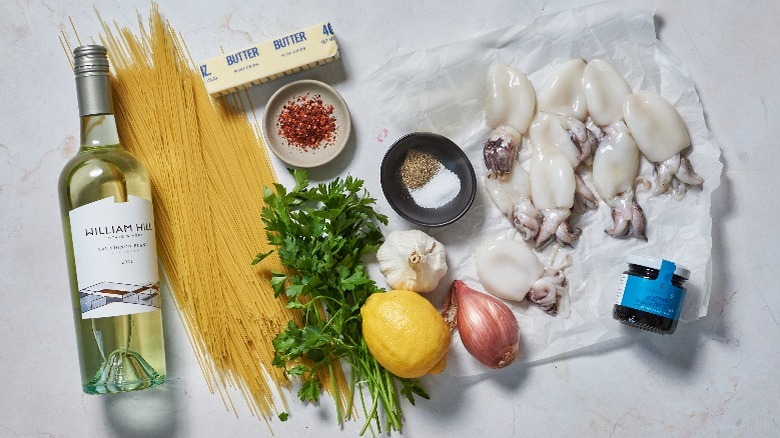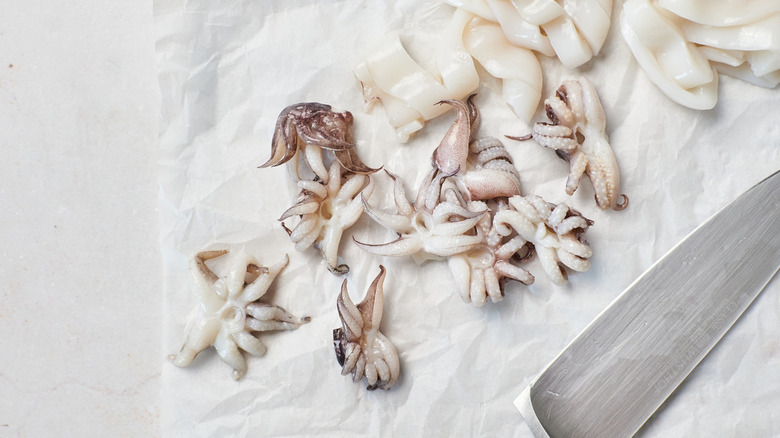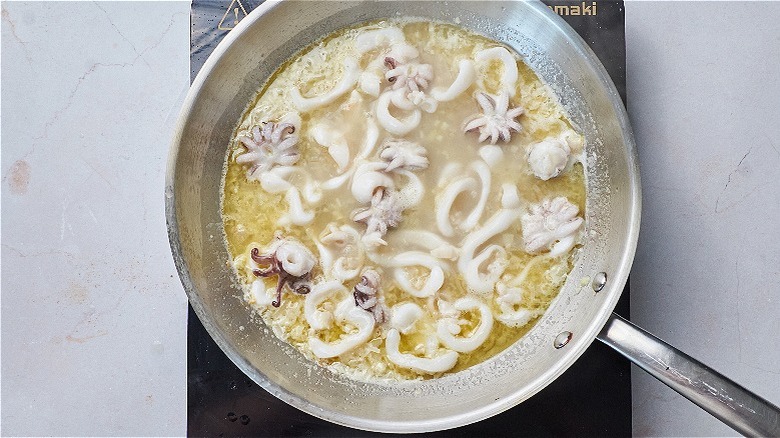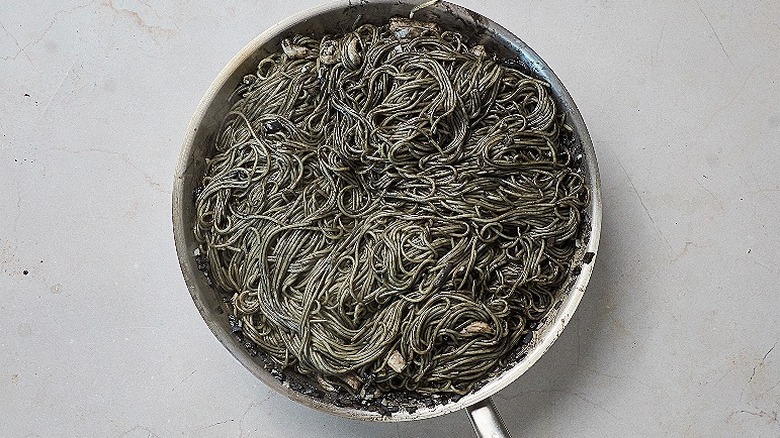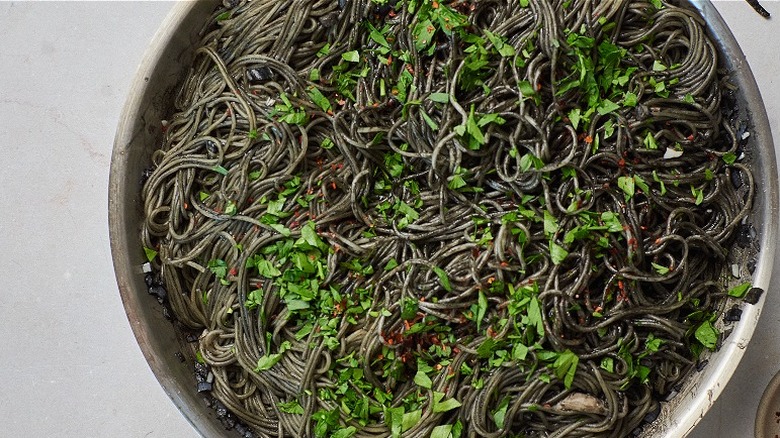Pasta Al Nero Di Seppia (Cuttlefish Ink) Recipe
Nero di Seppia is Italian for "cuttlefish ink" and is a popular condiment to use in the area of Sicily where cuttlefish ink pasta is rumored to have originated. Squid, octopus, and especially cuttlefish have long been valued by fishermen of Italy and added to various coastal dishes like pasta, fritto misto, and salad. To be as resourceful as possible, chefs and fishermen use every part of the squid, even including the ink sack that is filled with black, salty liquid. Believe it or not, this ink is edible, and it is totally delicious.
Squid and cuttlefish ink can be mixed into the flour while making pasta or stirred into the sauce that covers it, depending on what kind of dish you want to make. In Sicily, it's common to see dishes like the recipe shared by Michelle McGlinn below, which incorporates the salty, fishy ink into a buttery white wine sauce. Of course, the best part of using cuttlefish ink is the color: The dark, inky liquid coats each strand of spaghetti in a bewitching, sensuous black tone, which later ends up stained around your teeth and tongue (it wipes away easily, Mcglinn promises). If you've never had cuttlefish ink pasta, try this simple, easy, and utterly delicious recipe — plus, pretty cool to look at.
Everything you need for pasta al nero di seppia
The traditional pasta types used in this dish is thin spaghetti or angel hair. You can use any shape, but we recommend using thinner, longer types that are suitable for thin, buttery sauces. For the sauce, you'll need butter, shallot, garlic, white wine, lemon juice, salt, and pepper, and then you'll need cuttlefish tubes and tentacles to toss in. Cuttlefish are very similar to squid and the two can be used interchangeably; if you live on a coast, tubes and tentacles should be easy to find fresh in local stores, while places more inland may require a hunt through the freezer aisles. If you can't find squid, try shrimp, which is available year-round in most markets and cooks the same way.
Of course, to create the jet-black color, you'll need squid or cuttlefish ink. Essentially the same thing from different mollusks, you can use either ink for this recipe. While you may be able to find a jar or packet in your local grocery store, you'll have better luck at Italian markets or by ordering online (the ink is shelf-stable and travels well).
To finish the dish, you'll just need parsley and pepper flakes. We used Aleppo pepper flakes, but you can use red pepper flakes or any red chile flakes you have on hand.
Preparing cuttlefish
The preparation for squid and cuttlefish is about the same: You need to separate the tentacles from the body by pulling or cutting them away, then clean and skin the body (if needed — many fishmongers will have already done this for you). Slice the cleaned tube of the body into ¼-inch rings, then slice right below the eyes still connected to the tentacles to remove them. If needed, remove the beak in the center of the tentacles and the long, soft tentacles connected to the arms. When finished, you should have around 8 clusters of curly, suction-cupped arms and a hefty handful of slippery off-white rings.
Simmer the cuttlefish
To begin the sauce, melt butter in a deep skillet (you'll be adding the pasta to the skillet, so make sure it is big enough to toss pasta in). Add the shallots and garlic and stir until fragrant, then splash in the wine and lemon juice. Arrange the cuttlefish rings and tentacles in a single layer around the skillet and simmer until the rings become firm and white and the tentacles curl into firm clusters. Remove the tentacles to serve as a garnish for the finished pasta.
Add the cuttlefish ink and toss with pasta
Carefully drop the ink into the skillet and stir well to combine — while the ink doesn't stain long-term, we suggest using a cheaper spoon or spatula for this. Bring the inky mixture to a simmer, then begin adding the cooked pasta. The best way to do this is by using tongs and adding the long noodles directly from the pasta water. This ensures the sauce thins and coats every strand. If you make the pasta ahead of time, just reserve a half cup or so to splash into the pasta instead. Like carbonara or cacio e pepe, the sauce is influenced by the pasta water, which helps flavor provide flavor and adhesion.
Toss with parsley to serve
Remove the now-inky pasta from the heat and toss the parsley into the skillet until well-incorporated. To serve, divide into pasta bowls and sprinkle with pepper flakes, then top with the cooked cuttlefish tentacles. This stunning centerpiece of a dish goes well with stewed peppers and tomatoes, grilled eggplant, and Caprese salad. It's especially delicious with a bottle of crisp white wine like the one used in the sauce, McGlinn recommends. Because the sauce is thin and quickly absorbed by the pasta, this dish is best enjoyed right away but if needed, can be stored for 3 to 4 days in the refrigerator and reheated in the microwave.
Pasta al Nero di Seppia (Cuttlefish Ink) Recipe
The next time you're looking for a seafood past recipe, try this pasta al Nero di Seppia made with cuttlefish and black ink sauce.
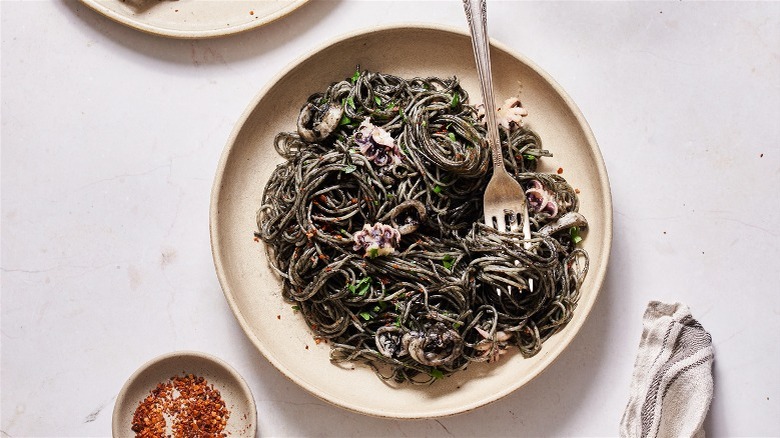
Ingredients
- 1 pound capellini or spaghetti, cooked to al dente
- 4 tablespoons butter
- 1 large shallot, finely diced
- 5 cloves garlic, minced
- ½ cup white wine
- 1 pound cuttlefish, tubes sliced into ¼-inch rings
- Juice from ½ lemon
- Pinch of salt
- Pinch of pepper
- 3 tablespoons cuttlefish ink
- ¼ cup chopped parsley
- 1 teaspoon Aleppo pepper flakes
Directions
- Heat butter in a large skillet over medium heat. Once melted, add the shallot and garlic and cook until softened, about 1 to 2 minutes.
- Add the wine and lemon juice to the skillet and bring to a simmer, then add the sliced cuttlefish tubes and tentacles. Add the salt and pepper and cook until the cuttlefish is opaque, firm, and milky white in color. Remove the tentacles and set aside for serving.
- While the cuttlefish is simmering, boil the pasta, but do not drain.
- Add the cuttlefish ink and stir into the sauce, which will have reduced slightly while the cuttlefish cooked. Once the ink is combined, use tongs to add the pasta directly from the cooking water.
- Toss the pasta with the ink sauce until completely coated. Once all pasta is black, toss it with parsley.
- Divide the pasta onto plates and garnish with the reserved tentacles. Sprinkle with pepper flakes to serve.
Nutrition
| Calories per Serving | 730 |
| Total Fat | 14.8 g |
| Saturated Fat | 7.8 g |
| Trans Fat | 0.0 g |
| Cholesterol | 252.7 mg |
| Total Carbohydrates | 93.2 g |
| Dietary Fiber | 5.0 g |
| Total Sugars | 5.3 g |
| Sodium | 809.4 mg |
| Protein | 48.1 g |
